Lecture 17: T helper cell subsets
1/27
There's no tags or description
Looks like no tags are added yet.
Name | Mastery | Learn | Test | Matching | Spaced |
|---|
No study sessions yet.
28 Terms
Explain the tole of the cytokines in Th subsets differentiation
Th1 Differentiation:
• Cytokines involved: Interleukin-12 (IL-12) and Interferon-gamma (IFN-γ).
• Function: Th1 cells promote cellular immunity, mainly by activating macrophages and enhancing the cytotoxic activity of CD8+ T cells. They are crucial for fighting intracellular pathogens like viruses and certain bacteria.
• Key Transcription Factor: T-bet (encoded by the TBX21 gene) is induced by IL-12 and IFN-γ, promoting the differentiation of Th1 cells and the production of IFN-γ.
2. Th2 Differentiation:
• Cytokines involved: Interleukin-4 (IL-4).
• Function: Th2 cells are important for humoral immunity and defense against extracellular pathogens, particularly helminths. They activate B cells to produce antibodies, particularly IgE, and support eosinophil responses.
• Key Transcription Factor: GATA3, which is activated by IL-4 signaling, drives Th2 differentiation and promotes the expression of cytokines such as IL-4, IL-5, and IL-13.
3. Th17 Differentiation:
• Cytokines involved: Transforming growth factor-beta (TGF-β), IL-6, and IL-23.
• Function: Th17 cells are involved in defending against fungal and bacterial infections and play a role in autoimmune diseases. They promote inflammation by secreting cytokines like IL-17, which recruit neutrophils and mediate tissue inflammation.
• Key Transcription Factor: RORγt (retinoic acid receptor-related orphan receptor gamma t), which is induced by TGF-β and IL-6, leads to the differentiation of Th17 cells.
4. Treg Differentiation (Regulatory T cells):
• Cytokines involved: TGF-β and IL-2.
• Function: Tregs are crucial for maintaining immune tolerance and preventing autoimmunity. They suppress excessive immune responses and regulate other immune cells to maintain homeostasis.
• Key Transcription Factor: FoxP3, which is induced by TGF-β, is essential for the differentiation and function of Treg cells.
5. Th9 and Th22 Differentiation:
• Th9: Induced by IL-4 and TGF-β, Th9 cells are associated with immune responses against helminths and tumors, and they produce IL-9.
• Th22: Induced by IL-6, Th22 cells produce IL-22 and play a role in skin immunity and inflammation.

Explain the role of “educated” dendritic cells in Th cell differentiation.
Dendritic cells are the most potent antigen-presenting cells (APCs) and are pivotal in initiating and shaping the adaptive immune response. They capture and process antigens, migrate to lymph nodes, and present the antigen to naive T cells. The type of signals DCs provide, including cytokine production, strongly influences the differentiation of Th subsets.
1. Cytokine Production by Dendritic Cells:
• DCs secrete different cytokines depending on the type of pathogen they encounter and the local microenvironment.
• IL-12: Secreted by activated DCs, promoting Th1 differentiation and IFN-γ production.
• IL-4: DCs in response to certain pathogens (e.g., parasitic infections) produce IL-4, which induces Th2 differentiation.
• IL-6 and TGF-β: DCs release IL-6 and TGF-β, which are crucial for Th17 differentiation.
• IL-10: In some cases, DCs secrete IL-10, which can promote the differentiation of Treg cells and limit inflammatory responses.
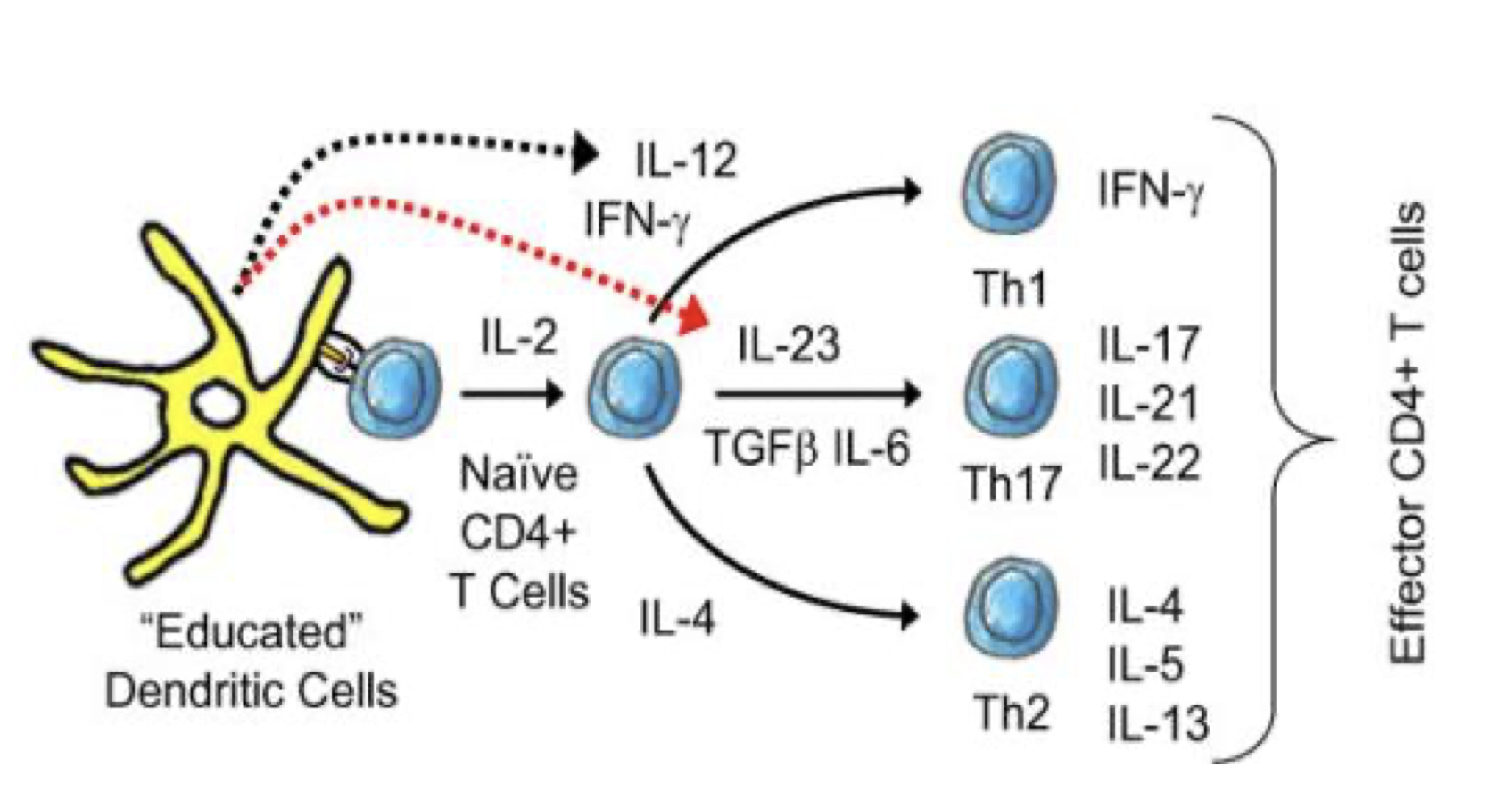
Describe the differences between the differentiated subsets of TH1, TH2 and TH17.
TH1 cell:
Signature cytokines: IFNγ
Immune reactions: macrophage activation; IgG production
Host defence: intracellular microbes
Role in diseases: Autoimmune disease; tissue damage associated with chronic infections
TH2 cell:
Signature cytokines: IL-4, IL-5 and IL-13
Immune reactions: Mast cell, eosinophil activation; IgE production; alternative macrophage activation.
Host defence: Helminthic parasites
Role in diseases: allergic diseases
TH17 cell:
Signature cytokines: IL-17A, IL-17F, IL-22
Immune reactions: Neutrophilic, monocytes inflammation
Host defence: Extracellular bacteria
Role in diseases: Organ-specific autoimmunity
What are the defining characteristics of the effector cells?
Cytokines they produce, the transcription factors they express, and the epigenetic changes in specific cytokine gene loci.
What is cytokine bias?
Th1/Th2 cytokine bias refers to the skewing of the immune response towards one of the two major subsets of helper T cells (Th1 or Th2), based on the types of cytokines present in the immune environment. T
he balance between these subsets is crucial for the immune system’s ability to respond appropriately to different types of pathogens and diseases. An imbalance in this system can contribute to various immune disorders such as autoimmune diseases, allergies, and chronic infections.
CD4+ T helper Subsets: How does Th1/Th2 Cytokine Bias play role in the difference between Th1/Th2 cells?
CD4+ T helper cells can be divided into subsets
based on their cytokine production
◼ Th1 cells produce IL-2, IFN-γ, TNF-β
CKs which activate cell mediated immunity
◼ Th2 cells produce IL-4, IL-5, IL-13
CKs that activate humoral immunity
What is the difference between Th1 cells and Th2 cells?
1. Th1 Cells:
• Th1 cells primarily promote cell-mediated immunity, which is important for defending against intracellular pathogens (e.g., viruses, certain bacteria, and parasites).
• They secrete cytokines such as Interferon-gamma (IFN-γ), Tumor Necrosis Factor (TNF), and IL-2, which activate macrophages, cytotoxic T cells (CD8+), and other immune cells involved in the defense against intracellular pathogens.
• Th1 responses typically result in the activation of macrophages, cytotoxic T lymphocytes (CTLs), and natural killer (NK) cells, promoting a strong inflammatory response that is effective at clearing infections but can also contribute to tissue damage in autoimmune diseases.
2. Th2 Cells:
• Th2 cells are mainly involved in humoral immunity, which is effective against extracellular pathogens, particularly parasites like helminths (worms), and allergens.
• They secrete cytokines such as Interleukin-4 (IL-4), IL-5, IL-13, and IL-10. These cytokines stimulate B cells to produce antibodies (especially IgE), activate eosinophils and mast cells, and promote responses that are more tissue-repairing but also involved in allergic responses.
• Th2 responses are associated with allergic reactions (e.g., asthma, rhinitis) and parasitic infections, where antibody responses are crucial for neutralizing pathogens or toxins.
What is Th1-Th2 competition?
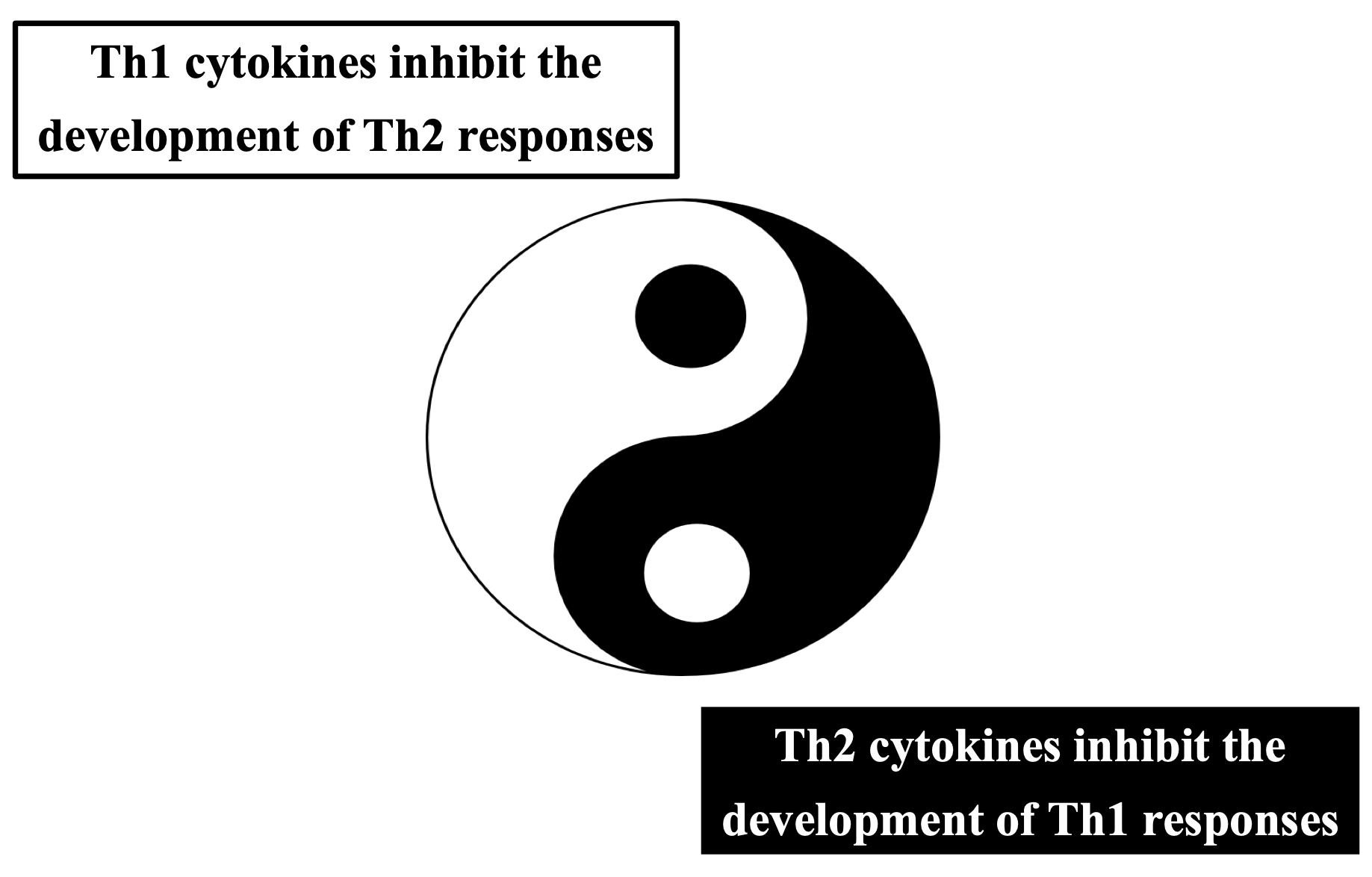
Explain how Th1-Th2 differentiation of a nǎive Th0.
Cytokines: IL-2, IL-4, IFN-γ
Add IL-12 to differentiate into Th1 effector cell
Add IL-4 to differentiate into effector Th2 cell
Effector Th1 cell : produce IL-2, IFN-γ
Effector Th2 cell: produce IL-4, IL-5, IL-13

What is Th1-Th2 antagonism?
Th1 Cytokines (e.g., IFN-γ):
• IFN-γ, produced by Th1 cells, is a potent inhibitor of Th2 differentiation. It suppresses the expression of the GATA3transcription factor, which is crucial for Th2 differentiation.
• IFN-γ also inhibits the production of IL-4, a key cytokine for Th2 polarization, thereby blocking the promotion of Th2 responses.
• Th2 Cytokines (e.g., IL-4):
• IL-4, the hallmark cytokine of Th2 cells, promotes the differentiation of Th2 cells by activating GATA3, the transcription factor that drives Th2 differentiation.
• IL-4 also suppresses the expression of T-bet, the transcription factor essential for Th1 differentiation, thereby inhibiting Th1 responses.
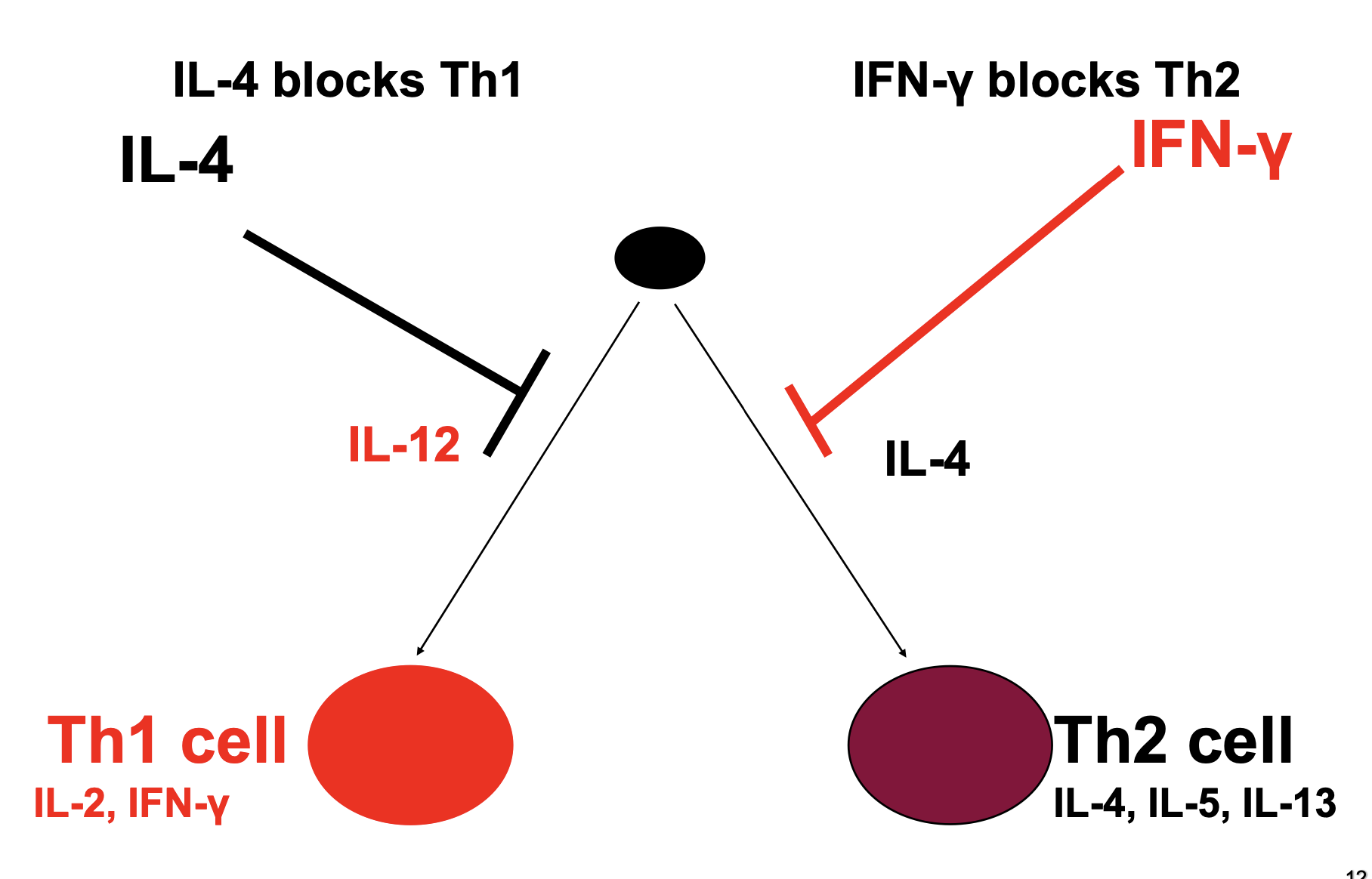
Explain Th1/Th2 Regulation: IL-4 versus IFN-γ.
T-Bet is a transcription factor that is required for Th1 specific genes such as IL-12Rβ
◼ T-Bet (Th1 associated): activated by IFN-γ and turned off by IL-4
◼ Conversely in Th2 transcription factor GATA-3: activated by IL-4 turned off by IFN-γ
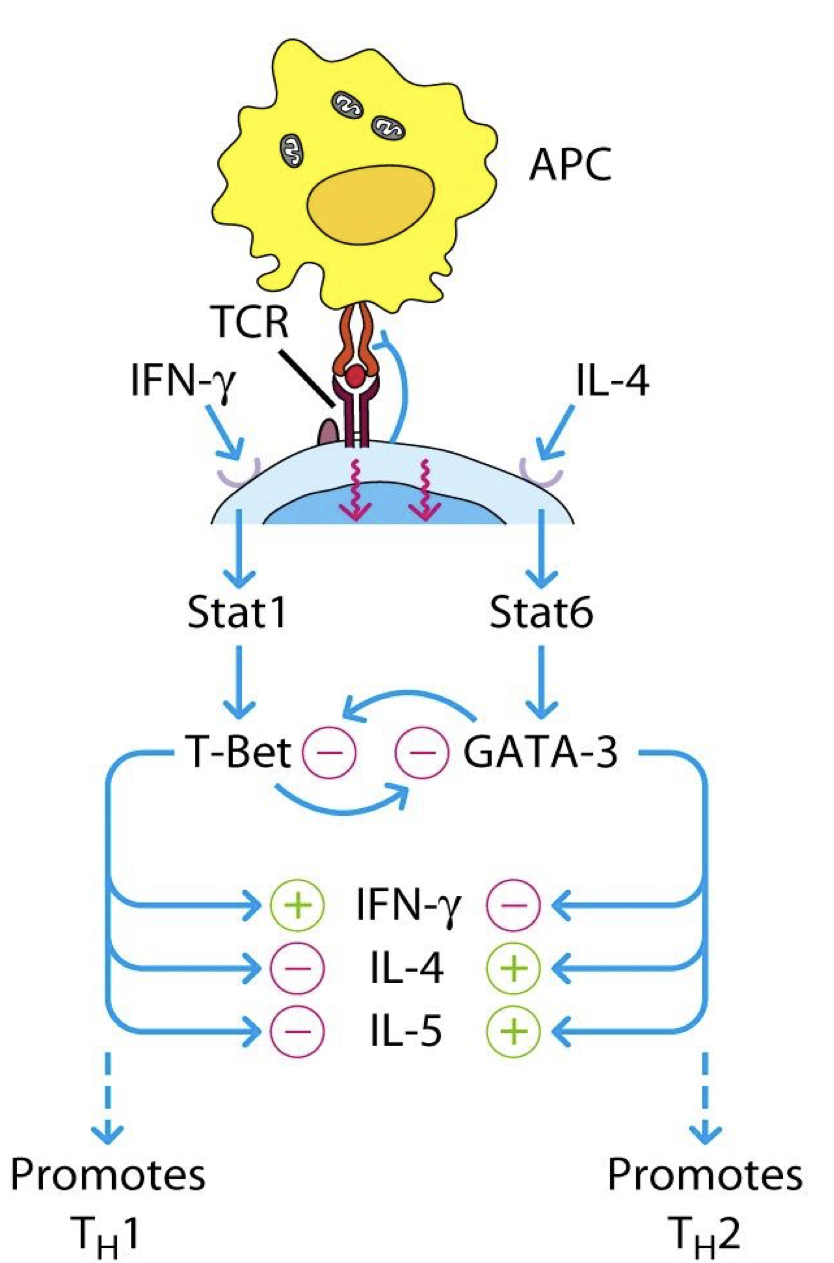
What are other factors directing Th1 versus Th2?
◼ Amount of antigen
Mouse experiments originally showed high dose for Th1
◼ MHC and TCR affinity
High affinity TCR = Th1
◼ Dendritic cell subsets during activation
APC subsets activate Th1 or Th2 preferentially
◼ Toll-like receptor (TLR) activation – which TLRs are engaged
What are the roles of Th1 cells and which cytokines do they produce?
Th1 cells are inflammatory cells which secrete: IFNγ, interleukin (IL) -2 and tumor necrosis factor (TNF)
They:
Stimulate macrophages through IFNγ : stimulation of their killing activities and elimination of intracellular agents.
Stimulate T cells: differentiate into Th1 profile (due to the IL-13 production by APC) and secretion of autocrine growth factor of T cells IL-2.

What are the roles of Th1 cells ?
Involved in
clearance of intracellular pathogens
delayed type hypersensitivity (DTH)
some organ-specific autoimmune diseases
Which cytokines are produced by Th2 cells and what do they do?
Cytokines produced: IL-4, IL-5 and IL-13
Function: Help B cells
◼ Antibody production by B cells is dependent on the help of Th2
◼ Cytokine dependent help: IL-4
◼ Cell contact dependent help: CD40 (B cell) - CD154 (T cell) interaction
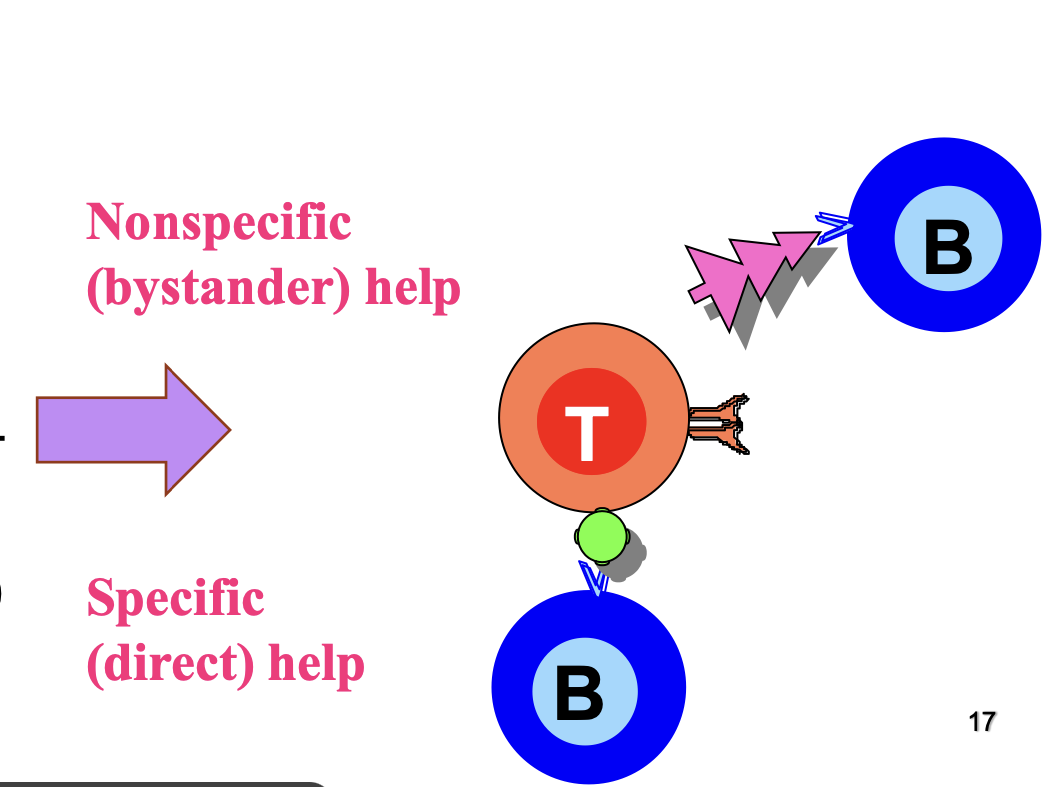
What are the major outcomes of Th2 cells?
Involved in
Defense against extracellular parasites (including helminths)
Major role in induction and persistence of asthma and other allergic diseases
Which Th subset is the first to be generated during infection?
Th17 cells
What are the roles of Th17?
combats microbes by recruiting neutrophils & macrophages & inducing inflammation
With IL-22, stimulates antimicrobial peptides (defensins) production in epidermal keratinocytes – enhances innate acute inflammatory response
Receptor is expressed on fibroblasts, epithelial cells and keratinocytes. Interaction with IL-17 leads to production of IL-6 and chemokines
Major effector lineage with pro-inflammatory
actions in diseases for Th17.
rheumatoid arthritis, psoriasis & Crohn’s disease (autoimmunity)
What do regulatory T lymphocytes express?
Express CD4+, high levels of the IL-2 receptor alpha chain CD25, critical for their development is the transcription factor FoxP3
⚫ CD4+FoxP3+CD25HIGH phenotype
How are Tregs generated?
Generated mainly by self-Ag recognition in the thymus and by recognition of self and foreign Ag in peripheral lymphoid organs
What are responsible for the generation of Treg?
Development of some Treg requires TGF-β →
FoxP3 → development and function of Treg
What does the survival and funcitional competence of Treg depend on?
Survival and functional competence is dependent on IL-2
Explain the mechanisms and functions of Treg.
Some of the best known mechanisms
Secretion of immunosuppressive (inhibitory) cytokines TGF-β and IL-10
Reduced ability of APCs to stimulate T cells.
Consumption of IL-2 – as they have high level of expression of IL-2 receptor
Induced after oral administration of antigens, play a role in the induction of oral tolerance
What are the roles of IL-10
Inhibitor of activated macrophages and dendritic cells –
controls innate immune responses and cell-mediated immunity
◼ inhibits IL-12 production; hence IFN-γ secretion
◼ inhibits expression of co-stimulatory and class II molecules
Negative feedback regulator – as it is both produced by a
What is IL-10 produced by?
Produced by a subpopulation of B cells – regulatory B cells
What is EBV?
Epstein Barr Virus (EBV) has a gene homologous to
human IL-10, same activities as the natural cytokine
⚫ EBV inhibits host immunity and provides a survival advantage
in the infected host
Outline the roles of TGF-β
Inhibits both macrophage activation & proliferation & effector functions of T cells
Regulates differentiation of functionally distinct T cell subsets
Stimulates production of IgA by inducing B cells to isotype switch
◼ mucosal immunity (induced after oral administration of antigens, play a role in
the induction of oral tolerance)
4. Promotes tissue repair after local immune and inflammatory
reactions subside
◼ stimulates collagen synthesis and matrix-modifying enzyme production by
macrophages and fibroblasts
◼ Note: might play an important role in diseases – with fibrosis (pulmonary fibrosis and systemic sclerosis)